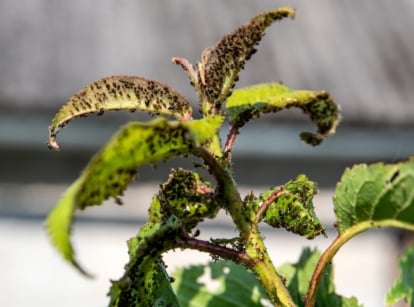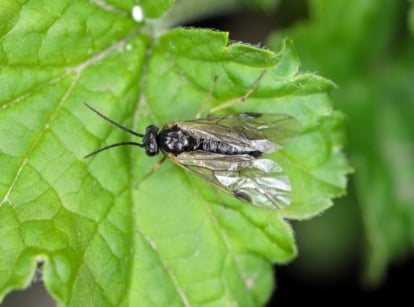How to Identify and Get Rid of Root Maggots
Root maggots can be a major problem around your root and cole crops. Learn about these larvae and the flies that spawn them in our pest guide by horticultural expert Lorin Nielsen.

Contents
If you’re noticing a proliferation of flies, and your brassicas or root vegetables are starting to yellow, it’s a warning sign. You may have a root maggot infestation.
These fly larvae are no joke! They will hungrily chew through your plants, causing them to lose vigor, wilt, yellow, and possibly die off.
Luckily, rescuing your plants from root maggots is possible. Read on to learn everything you need to know about these garden pests and how to wipe them out.
What are Root Maggots?

Root maggots are the larvae of various species of flies. These small larvae feed on the roots of plants, causing significant damage. Infestations can lead to stunted growth, yellowing leaves, and even the death of the plant as the maggots undermine its ability to take up water and nutrients.
Root maggot infestations often go unnoticed until the damage becomes severe, as the larvae feed underground. In severe cases, plants may be easily pulled from the ground due to weakened roots.
Types of Root Maggots
While there are quite a number of flies in the Delia genus, only a few have reached major pest status. I’ll list the worst offenders below.
Delia radicum

Feeding on primarily cruciferous plants, this species of root maggot can be found worldwide. Cabbage maggot infestation causes a slowing of growth, followed by yellowing leaves and wilting. For smaller plants like radishes, a cabbage maggot infestation can quickly ruin an entire crop.
There is another relative among the cabbage root maggot category, called Delia floralis (the summer cabbage fly or cabbage maggot). This fly looks incredibly similar and eats many of the same plants. It’s similar enough, in fact, that it is often confused with Delia radicum. Thankfully, this cabbage maggot can be wiped out with the same techniques.
The nearly undetectable fly (due to its size) lays eggs that look like cream-colored bullets in the soil around crops. They are most active in spring When the eggs hatch, the white, legless cabbage maggot feeds at the base of the plants above and below ground.
Delia antiqua

Scallions, onions, leeks, and other related plants are susceptible to the onion root maggot. Preferring plants in the allium family, they will bore into and devour the tender interior of a leek plant, or eat giant holes through onions. This causes dramatic yellowing of leaves and visible wilt quite quickly.
Just like other flies, these are difficult to distinguish with the naked eye. Their eggs are white, laid at the base of allium plants. Larvae are cream-colored.
Delia platura

Peas, beans, and corn are susceptible to the seedcorn maggot. However, any larger-seeded edible plants may fall prey to this seed-eater. Burrowing through the soil, it can easily chew through any of the seeds before or during germination.
Life Cycle

In the spring, the root maggot fly emerges from the soil where it overwintered in pupal form. It feeds on plant nectars to build its strength, then seeks out its preferred larval food source as an ideal location to lay eggs.
Thirty to forty eggs can be laid along the base of the plant or on the ground around it. Often, multiple root maggot flies will lay eggs on the same plant. Eggs hatch within five to fourteen days, which can be disastrous for the crop around which the eggs were placed.
Root maggot larvae then commence feeding on their preferred plant for up to forty days. The damage is not always below the soil. As an example, cabbage maggots can start at the base of the plant and chew their way up into the interior heart, or down through the root mass. This is one of the characteristics of cabbage maggots and can help you identify them.
Once satiated, the maggots retreat to form a pupa beneath the soil’s surface. It can take a while for these adult flies to mature during pupation. There’s usually only one or two generations in a given year.
Common Habitats

Generally speaking, cabbage flies and cabbage maggots are common around rutabaga, cabbages, turnips, radishes, or other cruciferous, large-rooted vegetables. However, some root maggots, like onion maggots prefer allium species like onion or leek. Others prefer the seeds of corn, peas, or beans.
These are primarily agricultural pests. As they’re soil-dwellers, they can be hard to wipe out in their destructive maggot form.
What Do Root Maggots Eat?

Generally, large-rooted plants of the brassica or allium families are susceptible. Virtually all cruciferous vegetables can be consumed, even broccoli. While garlic is usually ignored, onions (especially sweet ones) are at risk. And, as mentioned above, some specialize in edible large seeds.
If the plant is a compact mass such as cauliflower or cabbage, it is quite possible to find a root maggot that’s eaten a pathway into the center of the leaf ball.
How To Get Rid Of Root Maggots
Root maggots are tricky because the adult form can easily escape, and the larval form is hidden beneath the soil. Prevention is the best policy, but there are a few other options that can be used to get rid of root maggots.
Organic Control

A traditional method of treating root maggots is with a lime soil drench. Using agricultural lime, soak one cup of lime in a quart of water overnight. Strain off the lime and then use the water to drench the soil around your plants. Lime can raise the pH of your soil, so it is good to do a soil test before you use this method.
While it should be a last resort measure after all environmental options are considered, you may also use a pyrethrin soil drench. Using a concentrated product, mix the pyrethrin solution in water thoroughly, then use that to soak the soil around your plants. This will combat other pests like flea beetles, but it also harms beneficial insects.
Environmental Control

When the pest is beneath the ground, beneficial nematodes are an excellent defense. These microscopic organisms will quite happily consume larvae of root maggots along with a host of other soil-dwelling pests.
Be sure to rotate your crops after each growing season. Crop rotation is a great way to avoid pest problems year after year, as they never build up in strong numbers in one spot.
When you have harvested the end of your crops, till your soil. Tilling will not help during the growing season, but if you’ve had signs of root maggots, late-season tilling will disturb their environment and bring some to the surface. Once above ground, they are able to be picked off by passing birds or other predators.
Prevention

Your first line of defense against root maggots is prevention. Floating row covers keep adult flies away from your plants, stopping them from egg-laying. If you’ve had problems with root maggot in prior years, please use this method with caution, as the row covers will also keep newly-emerged adults underneath!
Diatomaceous earth is a deterrent for many types of garden pests. Dusted on your plants and over the surface of the soil, this superfine powder feels like knives to the soft bodies of root maggot flies.
A good soil-surface option is to make tarpaper collars to surround your plants. Roofing tarpaper works well. Cut circles that are four to six inches in diameter. Make a single straight cut into the center, and then cut out a small circle for your plant stems. Place this on the soil around the plant’s stem to discourage egg-laying.
Toilet paper tubes can also be used to deter root maggots. Cut along one side and place it around your plant, and then bury part of the tube in the soil. Be sure to leave at least an inch and a half above the soil’s surface. This creates a protective ring around your plant.
Yellow sticky traps placed around your plants can capture all sorts of flying pests, preventing them from laying eggs. Check your traps regularly and change them when necessary. Note that these will catch other insects as well.
Frequently Asked Questions
Do used coffee grounds and tea leaves keep out root maggots?
While there’s never been conclusive evidence that these repel root maggots specifically, coffee grounds can deter a number of other pests. Tea leaves are not much different than other leaf products, and don’t have any significant effects on pests.
The use of coffee grounds as a deterrent for soil-bound pests actually is based on unused coffee and its acidity. When planting your seeds, you can spread a small amount of coffee grounds in the area where you’re planting. Similarly, sprinkle coffee grounds around your transplants when you put them in the ground.
Why do I have root maggots?
The most common reason is the time is right! The adult flies that lay their eggs around your crops are active in spring and summer. Use preventative methods to keep their babies at bay.
Should I be worried about maggots?
You don’t want to accidentally eat one as you could get bacterial poisoning from them. They can also harm your crops. So be on the lookout and use preventative measures to control them.








